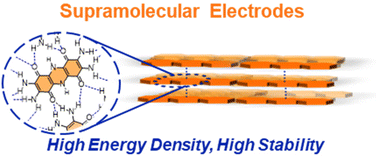Supramolecular design as a route to high-performing organic electrodes
Abstract
Organic electrodes may someday replace transition metals oxides, the current standard in electrochemical energy storage, including those with severe issues of availability, cost, and recyclability. To realize this more sustainable future, a thorough understanding of structure–property relationships and design rules for organic electrodes must be developed. Further, it is imperative that supramolecular interactions between organic species, which are often overlooked, be included in organic electrode design. In this review, we showcase how molecular and polymeric electrodes that host non-covalent interactions outperform materials without these features. Using select examples from the literature, we emphasize how dispersion forces, hydrogen-bonding, and radical pairing can be leveraged to improve the stability, capacity, and energy density of organic electrodes. Throughout this review, we identify potential next-generation designs and opportunities for continued investigation. We hope that this review will serve as a catalyst for collaboration between synthetic chemists and the energy storage community, which we view as a prerequisite to achieving high-performing supramolecular electrode materials.

- This article is part of the themed collections: Recent Review Articles and Nanoscale 2024 Emerging Investigators


 Please wait while we load your content...
Please wait while we load your content...